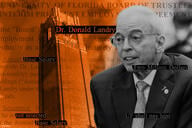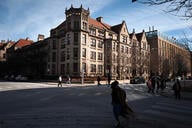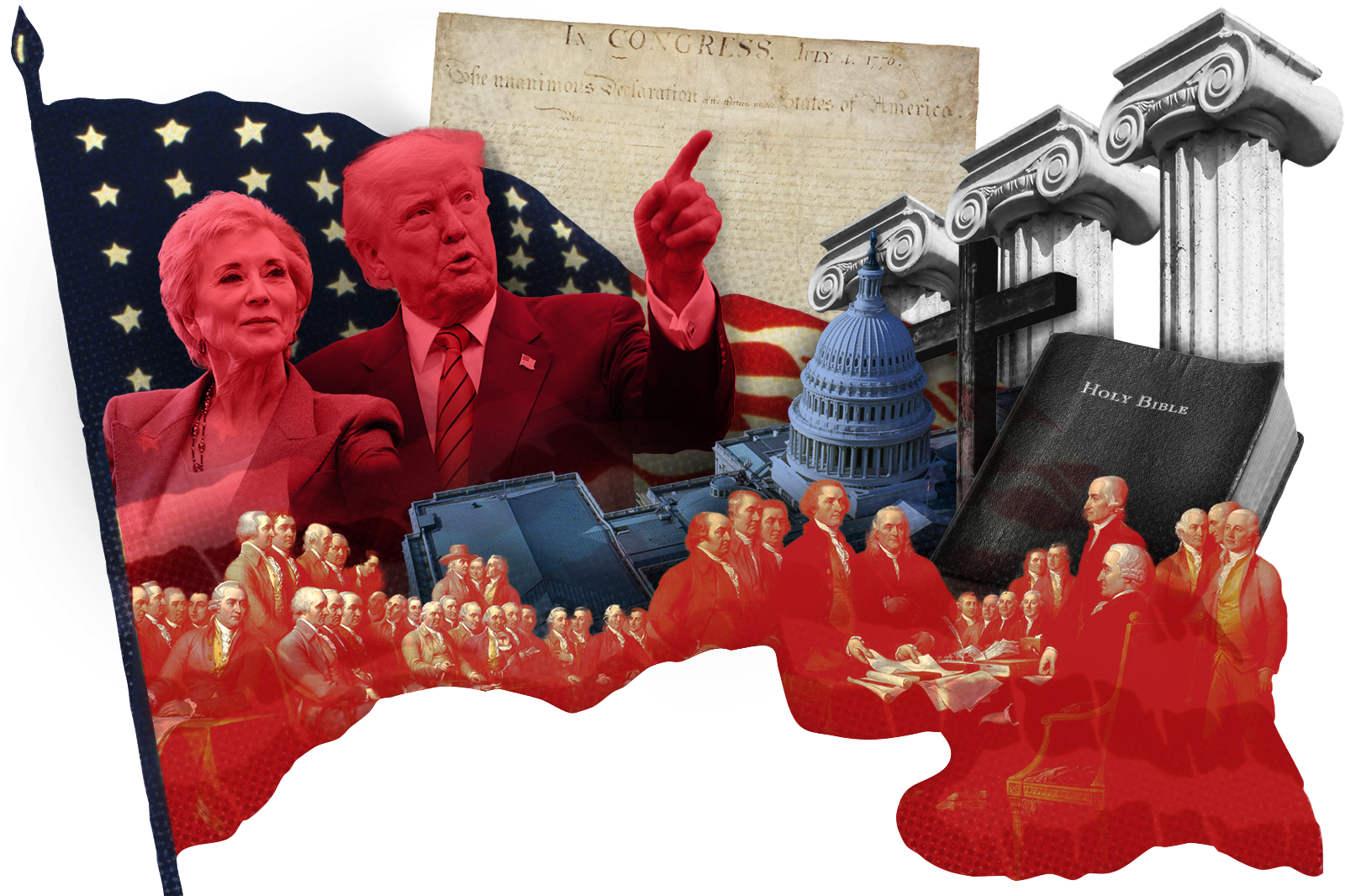
The Battle for ‘Viewpoint Diversity’
Conservatives in and outside of higher ed have long argued that universities lack their perspectives. But empowered Republicans are now deploying tools including legislation and funding threats to force higher ed to incorporate more right-leaning views.
By Ryan Quinn
Viewpoint diversity. Civics. Western civilization.
Republicans and conservative-leaning groups across the country have been using these terms prolifically, and at times interchangeably, to explain what’s lacking in higher education today and why the overhauls they’re pushing are necessary to save the sector from domination by the left. They’ve written op-eds, used social media and passed numerous state laws seeking to increase the likelihood that faculty will teach and research topics they’re interested in.
Now the White House is fueling their push, demanding viewpoint diversity under threat of huge funding cuts. Some say universities need to reform themselves to regain public and governmental support. But even academics and higher ed observers who may agree that universities have become too one-dimensional now find themselves defending the academy against a conservative campaign to force change under the banner of terms that sometimes sound like euphemisms.
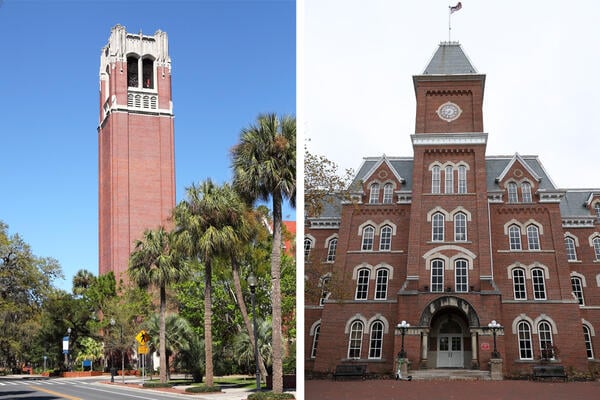
The University of Florida and Ohio State University are two of the institutions that established a civics center over the past decade.
To take one example of conservatives forcing change, Indiana Republicans last year passed Senate Enrolled Act 202, which threatens the jobs of even tenured faculty at public universities who don’t foster intellectual diversity. The law leaves it to university boards of trustees to define what intellectual diversity means in individual disciplines, to gauge whether professors have delivered it and to decide how much they should be punished if they fail. But already a Jewish professor at Indiana University at Bloomington—who’s a prominent pro-Palestinian protester—says he has been reprimanded under a university policy based on the law.
The Trump administration has also wielded intellectual diversity as a weapon in its demands of some of the nation’s wealthiest universities. In a letter to Harvard in April, government officials said that in order to get its federal research funding restored, the university must, among other things, employ a federally approved external party to “audit the student body, faculty, staff, and leadership for viewpoint diversity.” It didn’t define the term.
“Every department or field found to lack viewpoint diversity must be reformed by hiring a critical mass of new faculty within that department or field who will provide viewpoint diversity,” the demand letter said. Same goes for teaching units, which were required to admit “a critical mass” of viewpoint-diverse students.
In response, Harvard’s president, Alan Garber, said no government “should dictate what private universities can teach, whom they can admit and hire, and which areas of study and inquiry they can pursue.” He said Harvard would—on its own—continue to nurture “open inquiry” and broaden “viewpoint diversity.”
Over the past decade, red state legislatures, and some governing boards, have sought to shape curriculum and scholarship by establishing more than a dozen civics centers at public higher education institutions, including Ohio State University and the University of Florida. In recent years, the creation of these centers has accelerated, with three more created just since President Trump’s re-election in November.
State legislators tasked West Virginia University’s new Washington Center for Civics, Culture and Statesmanship with expanding “intellectual diversity,” offering “programming related to the values of open inquiry and civil discourse” and enriching the curriculum with the “great debates of western civilization.” Iowa’s Legislature created a “center for intellectual freedom” at the University of Iowa, ordering it to offer “civil discourse” programming and expand “intellectual diversity.” Similarly, Utah’s Legislature created a civic center at Utah State University committed to “viewpoint diversity and civil discourse” and mandated that all general ed courses be taught by faculty appointed to that center by its director. Those courses must include three that engage with “primary texts predominantly from Western civilization,” such as ancient Israel, Greece or early Christianity. There’s no mention of Islam.
There are also institutes or programs with similar-sounding missions, including more than 25 in the Foundation for Excellence in Higher Education network, which operate on or near highly selective university campuses such as Columbia, Harvard and the University of Chicago. Their websites say they promote the study of civics, civil discourse, Western thought and more. FEHE’s president leads the conservative Witherspoon Institute think tank, and the network receives millions of dollars from conservative foundations.
And the campaign for viewpoint diversity isn’t restricted to laws or centers imposed on universities. Some institutions are choosing to partner with conservative organizations. Johns Hopkins University—which has lost $800 million through Trump’s cuts to the U.S. Agency for International Development—is promoting its pact with a right-leaning think tank, the American Enterprise Institute. In an April post on its website, the university said it intends to increase intellectual diversity—and made clear what that means.
Johns Hopkins and AEI aim “to encourage conservative, libertarian and heterodox students and graduates to consider a career in higher education, and to support them in their efforts,” officials wrote. To achieve that, they tapped faculty to mentor “talented young ideologically heterodox students” interested in academe.
The university noted that President Ron Daniels “has sought to support the recruitment of conservative intellectuals to Hopkins” in various ways, including by creating “a heterodox faculty cluster” to help departments in the arts and sciences recruit scholars “with demonstrated interest and expertise in conservative theory and perspectives.”
Appropriately enough, disagreement abounds about whether—and in what areas—universities lack sufficient viewpoint diversity and what should be done about it.
Intellectual diversity works one way, and it always works in the way of conservative thought.”
—Isaac Kamola, director of the AAUP's Center for the Defense of Academic Freedom
“Intellectual diversity works one way, and it always works in the way of conservative thought,” said Isaac Kamola, director of the American Association of University Professors’ Center for the Defense of Academic Freedom and an associate political science professor at Trinity College in Connecticut. Those who say they favor intellectual diversity never say, “We need Marx in the business school,” he added.
Musa al-Gharbi—an assistant professor and sociologist in Stony Brook University’s School of Communication and Journalism and a research fellow at Heterodox Academy, which promotes viewpoint diversity and open inquiry—believes there is a problematic lack of intellectual diversity in academe. But deploying the concept hypocritically, the way Trump did in the Harvard demand letter, is harming good-faith efforts to address it, he said.
“If this is the suite of policies and dispositions that come to be associated with terms like viewpoint diversity and so on,” al-Gharbi said, “it’s going to be a real poison pill for the whole movement.”
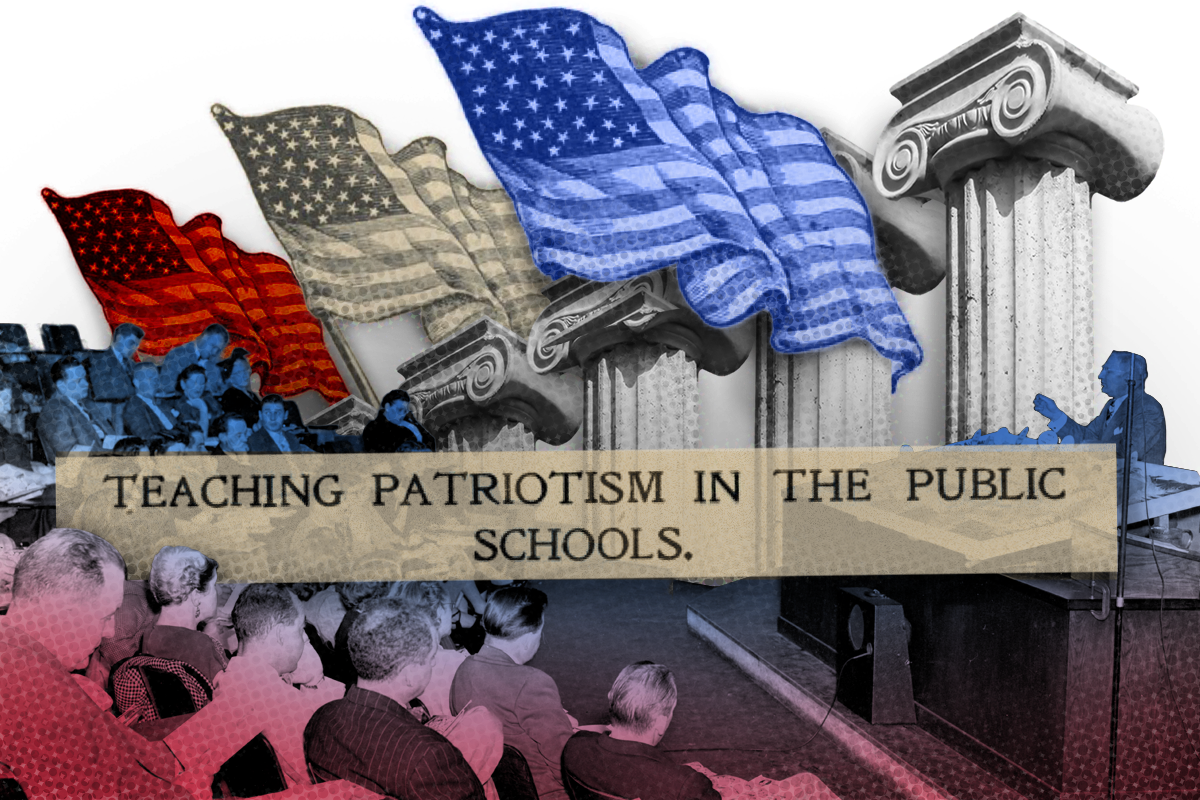
Photo illustration by Justin Morrison/Inside Higher Ed | JHU Sheridan Libraries/Gado/Getty Images | Library of Congress | Rawpixel
Origins of Faculty Liberalism
Faculty have been a left-leaning group going back to the 1930s, said Neil Gross, a Colby College sociology professor. They’ve drawn strong political attacks for as long, he added, citing McCarthyism in the 1950s and the publication of “God and Man at Yale,” an attack on secularism and collectivism by William F. Buckley Jr., founder of the conservative magazine National Review.
“This is kind of a long-standing theme in American life, and you see a version of it playing out in other countries as well,” said Gross, author of Why Are Professors Liberal and Why Do Conservatives Care?
“There is something about the nature of the search for new truth and for new ideas and for new ways of organizing and arranging society that is at odds with a certain vision of conservatism as stability and opposition to change,” Gross said. U.S. faculty have become increasingly left-leaning, a trend he links partly to institutions shifting their primary focus from teaching to research.
Since early in the 20th century, the public has associated being a professor with being on the left or having more radical sensibilities, he said. And liberals appear to self-select academe early in their intellectual development; left-leaning high schoolers are more likely than right-leaning high schoolers to say they want a Ph.D. As students age and make decisions about their future, “at each of those choice points you find many more liberals than conservatives in that pipeline going for the academic position,” Gross said.
Discrimination against conservative faculty applicants doesn’t seem to be a major factor. “There aren’t enough conservatives applying for academic jobs” for even “rabid” discrimination to account for the difference, he said.
What’s new about the current movement is that “folks on the right who want to change higher ed in political or ideological terms just have more power than they did previously,” he said.
Critics say a lack of ideological diversity can definitely have a negative impact on teaching and research. Heterodox Academy formed a decade ago to promote viewpoint diversity, and al-Gharbi has been with the group almost that entire time. The founders didn’t seek to add more conservative and religious voices to academe because they favored those views; they did it because academe, lacking those voices, was producing work with “glaring errors” in studies of race, conservative politics and other subjects, he said.
Al-Gharbi said faculty hiring, institutional review boards, peer review and other group decision-making aspects of higher ed “only work as they are intended when you actually do have diversity.” Without it, these systems “just reinforce the blind spots.”
In his book last year, We Have Never Been Woke: The Cultural Contradictions of a New Elite, al-Gharbi shows the myriad ways full-time faculty don’t generally reflect the rest of America. As of 2019, about 62 percent of professors identified politically as on the “left,” compared with just a quarter of Americans over all above age 25; about one in 10 was on the “right,” compared with 37 percent of Americans.
But the disparities go beyond ideology, he stressed. Only 6 percent of full-time faculty are Black—less than half the proportion of Americans —and 6 percent are Hispanic, while Hispanics make up 18 percent of the general population.
Al-Gharbi wrote in The Chronicle of Higher Education that professors “are overwhelmingly relatively affluent, urban and suburban whites who graduated with terminal degrees from the top programs in their fields.” Rather than focus on the faculty’s ideological tilt, it’s more useful for reformers to “understand these institutions as oriented around the interests and worldviews of highly-educated and relatively well-off urban and suburban whites,” he wrote. “If universities seem ‘woke,’ this is downstream from the fact that these institutions are dominated by a narrow and idiosyncratic slice of society who deploy ‘social justice’ as a weapon in their struggles over power, resources and status.”
But al-Gharbi told Inside Higher Ed that many of the people now calling for viewpoint diversity are actually just pushing a conservative political agenda. A good way to tell whether they actually support pluralism and open inquiry is if they “walk the walk” when they take power, he said—or instead “impose orthodoxies even after complaining about orthodoxies.” As an example of this, al-Gharbi pointed out that the Trump administration is deporting students for political opinions and defunding research on topics it disagrees with.
The actions of people like Trump and Rufo make it a lot harder for actors who are actually interested in improving teaching and research to advocate for some of these causes in the way that they used to.”
—Musa al-Gharbi, sociologist and research fellow at Heterodox Academy
“The actions of people like Trump and [Christopher] Rufo make it a lot harder for actors who are actually interested in improving teaching and research to advocate for some of these causes in the way that they used to,” al-Gharbi said. (Asked by Inside Higher Ed for a response, Rufo sent an email that said, “Heterodox Academy is a therapy program for centrist academics. That might be valuable for some, but it is hardly a substitute for real, action-oriented reform. I have never met a group that has thought so much of itself, while accomplishing so little.”)
Jenna Silber Storey, an AEI senior fellow, said in an email to Inside Higher Ed that conservatives’ scarcity in academe is partly due to “marginalization of certain areas of inquiry, certain subfields, that are generally interesting to those with a conservative disposition,” such as constitutional law, diplomatic history and moral philosophy.
“At first, the marginalization of conservatives in academia might have been accidental,” she wrote. “But when there are very few conservatives on campus, it becomes easy to think that they don’t really belong there, and that becomes a self-fulfilling prophecy.”
Storey has been working on the Johns Hopkins partnership with AEI. But she’s also pushing a much bigger movement: civics centers.
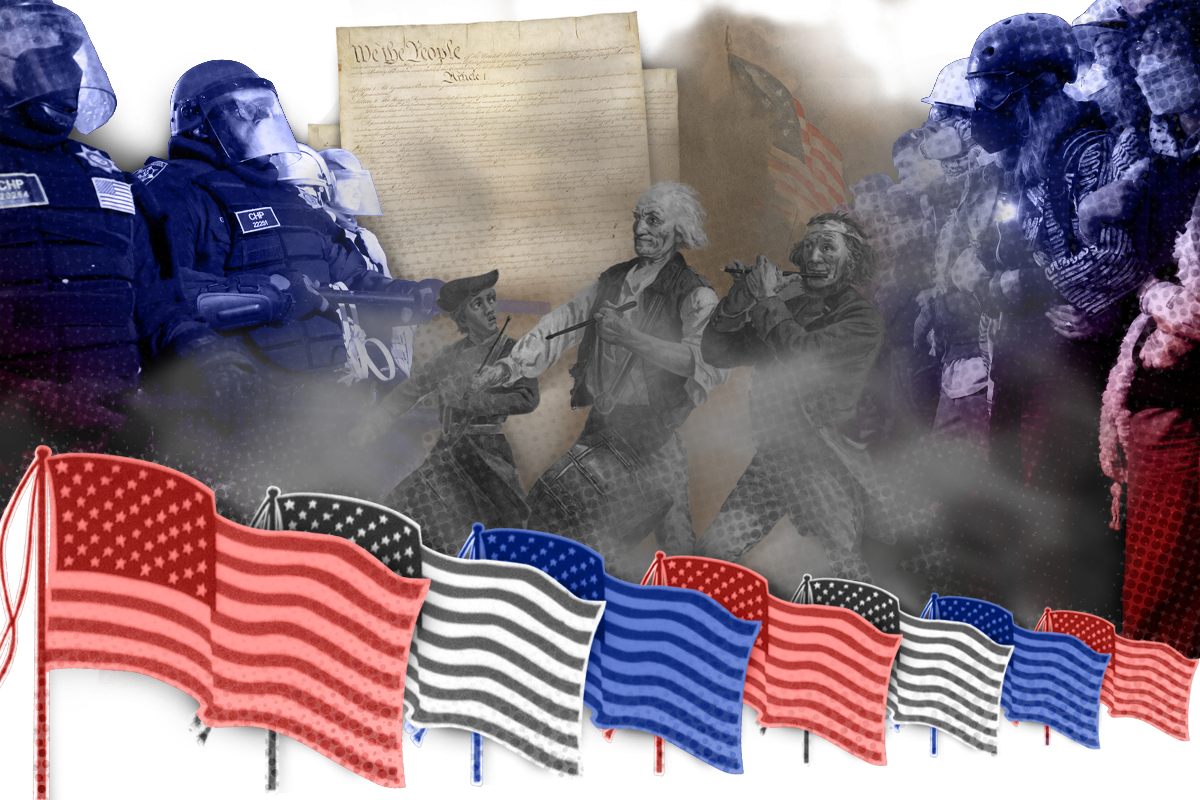
Photo illustration by Justin Morrison/Inside Higher Ed | Etienne Laurent/AFP/Getty Images | Library of Congress | U.S. National Archives
Civics as a Partisan Issue?
In 2016, Arizona State University became the first public institution to receive an order and funding from a State Legislature to establish a department “of civic thought and leadership.” But the movement has picked up in recent years. Op-eds promoting such centers have proliferated; in a 2023 op-ed in The Washington Post, Ramesh Ponnuru, editor of National Review, advocated for civics centers as an alternative to conservative legislative attempts to restrict teaching.
“There’s no way to regulate an overwhelmingly left-wing professoriate into making a fair presentation of conservative ideas,” Ponnuru wrote. “The goal should be to have more viewpoints, not fewer, represented on campus.”
Others have advocated for civics as a way to promote American democracy and ideals.
On Election Day 2024, Chance Layton, spokesperson for the conservative National Association of Scholars, wrote on his group’s website that the next president should “discourage academic multinational partnerships with undemocratic countries and prevent the use of area studies as an outlet for anti-American propaganda.” He added that strong civics education “could further erode these malign actors.”
The next day—when Trump’s victory was clear—the conservative American Council of Trustees and Alumni shared Layton’s column on X, adding that “a new administration means new ideas on the table. You know that we’re pulling for stronger civics education.” Among other things, ACTA seeks a requirement that all undergraduates pass a course covering America’s founding principles.
Steve McGuire, ACTA’s Paul and Karen Levy Fellow in Campus Freedom, told Inside Higher Ed that “many of the new civics centers have been created with bipartisan support because lawmakers, trustees and other stakeholders with different political views and partisan affiliations” see their value.
“It is important for our colleges and universities to help students become knowledgeable and thoughtful citizens who can listen to the views of others and disagree civilly,” he said. “Of course, successful civics centers will look to hire faculty who are intellectually and pedagogically supportive of their missions, but this does not involve screening candidates for political partisanship.”
Michael Poliakoff, ACTA’s president and chief executive officer, expounded on the need for civics centers the following month in a National Review article co-authored by Jack Miller, founder of the Jack Miller Center.
“Too often, instead of engaging with America’s founding principles and history, students hear about the supposed oppressiveness of Western civilization and the American ‘slavocracy,’ with dogmatic teaching of oppressor/oppressed ideas,” they wrote. They proposed that the new institutes would “tell the complete American story—its warts but also its promise.”
The Jack Miller Center, which spun off from the conservative Intercollegiate Studies Institute think tank and focuses on civics education, says it has been “strategically investing in scholars dedicated to the American political tradition, creating a talent pipeline to meet the hiring needs” of university civics centers.
Hans Zeiger, president of the Jack Miller Center and a former Republican state senator in Washington, told Inside Higher Ed, “We do not describe ourselves as a conservative organization. There are members of our academic network for whom that designation would not apply.” He said a push for civics education is necessary because “it has not been the central focus of the disciplines within academia to prepare active, informed citizens who can lead in a constitutional democracy.”
Kamola, of the AAUP, said stand-alone civics centers “pathologize” his and other faculty’s research and teaching—such as on America’s racist history—as somehow not civic. He said such centers aim to create “a safe space, if you will,” in which conservative ideas that have fallen out of favor in academe through the evolution of decades of scholarship can re-enter, without having to go through the normal faculty vetting of curriculum.
While Kamola says there is good-faith civics education, he also sees the current push for it and viewpoint diversity as a response to the Black Lives Matter movement that began on campuses in the 2010s. That movement escalated after George Floyd’s murder in 2020, he said, prompting “a real freakout, a collective freakout, about the fact that these ideas about structural power were literally taking to the streets.”
“All of that kind of organizing—like a lot of civil rights organizing before it—was interpreted as being hostile or uncivil,” he said. But there is a group of protesters who think “civil discourse is insufficient, or that getting together in a room and talking about hard ideas is insufficient” and at worst “masks and then perpetuates the structural inequality,” he said.
The push for civil discourse gained urgency amid the recent pro-Palestinian campus protests—including the student protest encampments. But for the students who participated in those encampments, Kamola said, “their take is they’re actively engaged in civics—they know what it means to be a citizen, they’re doing it.”
Storey, of AEI, said faculty in the civics centers “all come from traditional disciplines and departments” and they generally “move to schools of civic thought because they think they have a better opportunity to do the teaching and scholarship they want to do in that context.”
“Academics should take this opportunity to ask themselves whether they are satisfied with the status quo on campus, whether they accept the marginalization of conservatives in their profession and the intellectual and political consequences that has for their institutions,” she said. “I hope that they will be motivated to undertake some changes to the culture of campus by the prospect of both greater intellectual vitality and more stable public support.”
Gross, the Colby College sociologist, sees a “practical” reason for introducing more conservatives into the faculty, beyond providing a counterpoint to voices on the right that are anti–vaccine or climate change science.
“It’s a very polarized country,” Gross said, “and if higher education does not have the support and confidence of people who are not just on the left, it will fail.”
